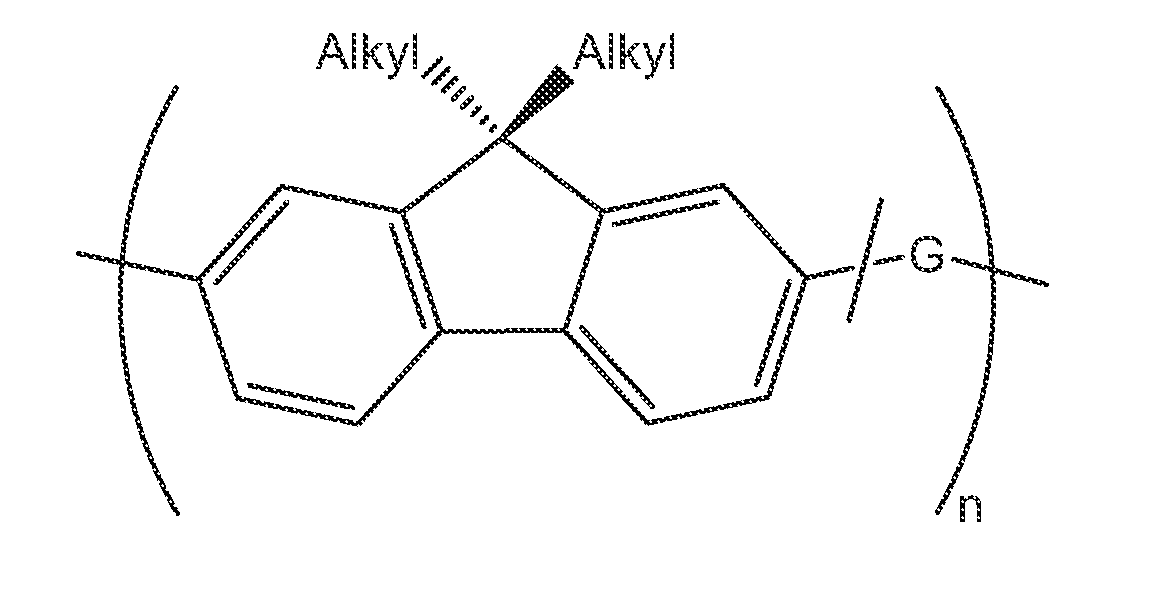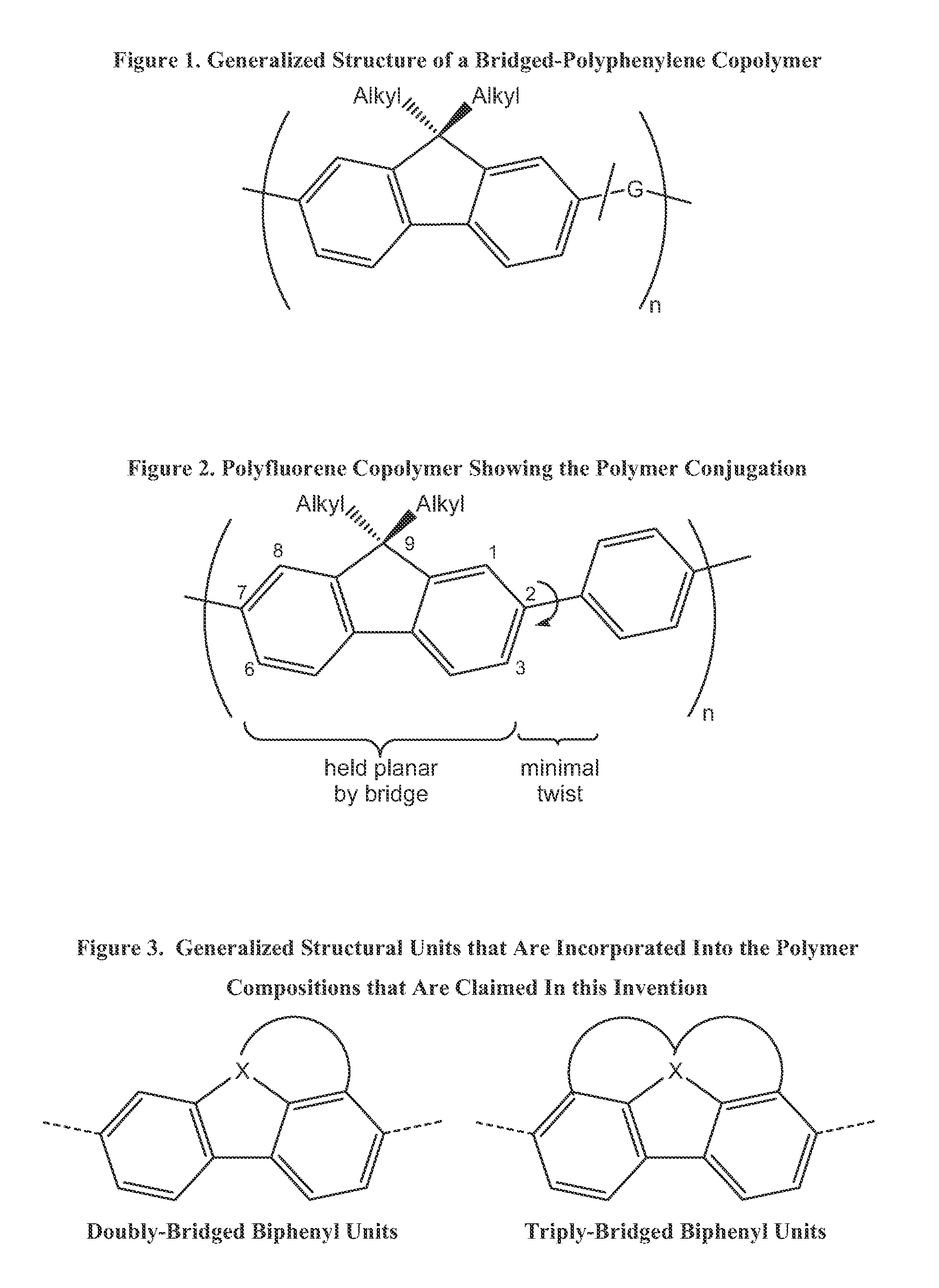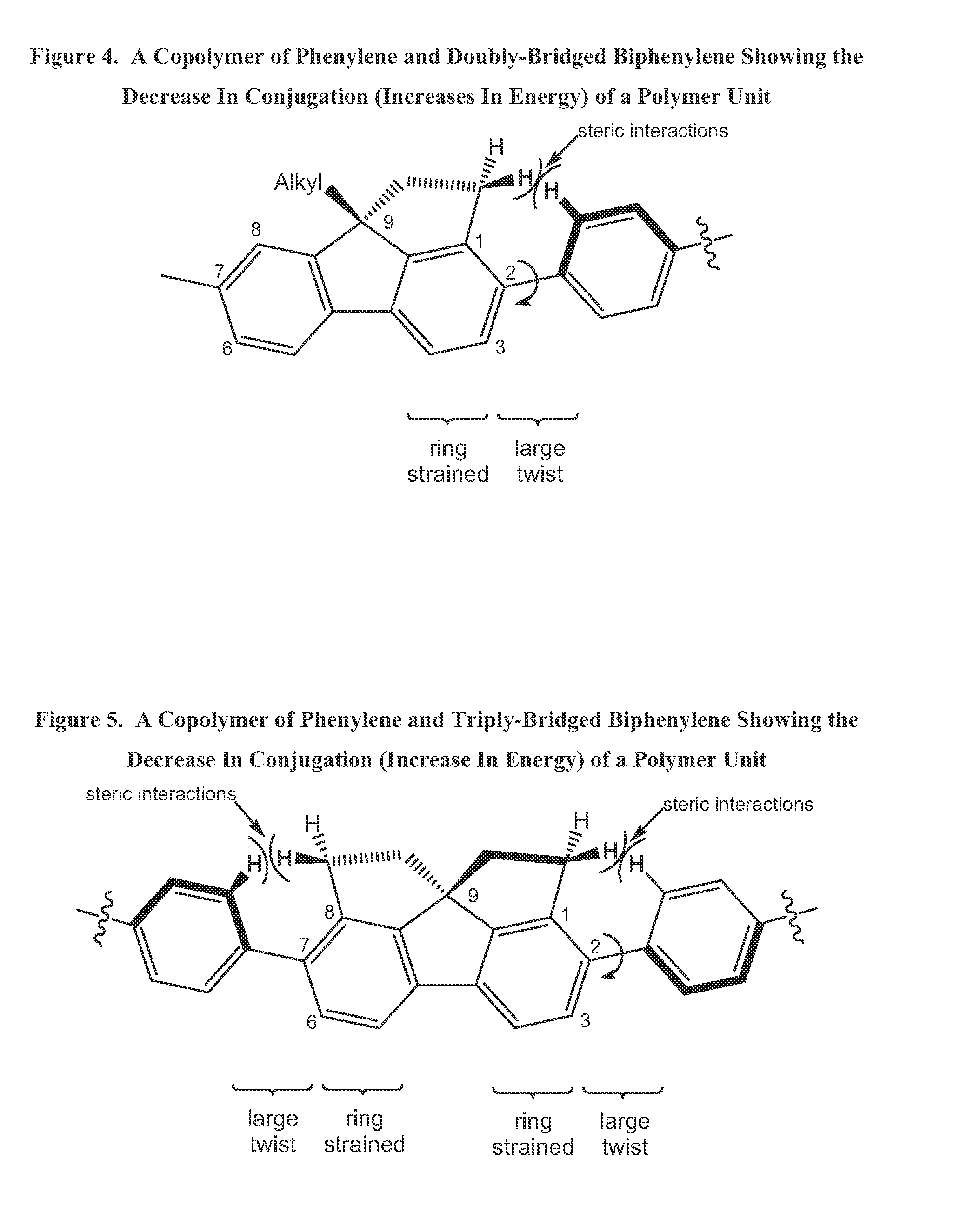Class of bridged biphenylene polymers
a biphenylene polymer and polymer technology, applied in non-linear optics, instruments, transportation and packaging, etc., can solve the problems of reducing the brightness of oleds and p-oleds as a function of time, affecting the commercial application of oleds and p-oleds, and affecting the efficiency of the excited emissive compound, so as to achieve the effect of improving brightness and/or lifetim
- Summary
- Abstract
- Description
- Claims
- Application Information
AI Technical Summary
Benefits of technology
Problems solved by technology
Method used
Image
Examples
example 1
Preparation of Polymer 6
[0182]
Preparation of 2,7-dibromo-9-hezylfluorene (2)
To a solution of 2,7-dibromofluorene (1, 0.060 mol) in dry THF (200 mL), under argon and at −78° C., is added 1.5 M solution of n-butyllithium in THF (0.060 mop over a 45 min period. After the addition, the temperature of the reaction mixture is allowed to rise to room temperature and stirred for 1 h. The mixture is then cooled to −78° C. and a solution of n-hexylbromide (0.060 mol) in THF (10 mL) is added over a 45-min period. The temperature of the reaction mixture is then allowed to rise to room temperature and allowed to stir for 12 h. The solution is neutralized with a 10% HCl solution and the THF is removed in vacuo. The resulting oil is purified by chromatography.
Preparation of 2,7-dibromo-9-hexyl-9-(2-bromoethyl)fluorine (3)
[0183]To a mixture containing aqueous potassium hydroxide (50 mL, 50%), tetrabutylammonium bromide (1 mmol), and 1,2-dibromoethane (25 mmol) at 75° C. is added 2 (5 mmol). After 1...
example 2
Preparation of Polymer 10
[0186]
Preparation of 2,7-dibromo-9-(3-bromopropylidenyl)fluorine (7)
[0187]To a stirred suspension of 2,7-dibromofluorene (1, 27 mmol) in pyridine (3 mL) at 0° C. under nitrogen is added a 1M solution of tetrabutylammonium hydroxide in methanol (6 mL). A solution of 3-bromopropanal (32 mmol) in pyridine (25 mL) is then added over a ten-minute period, and the solution is allowed to stir at room temperature for 2 h. The mixture is poured into 300 mL of ice water, stirred for 3 h, and the resulting solid is collected by filtration and purified by chromatography.
Preparation of 8
[0188]To a solution containing 7 (0.75 mmol) and CH2Cl2 (15 mL) is added aluminum trichloride (0.75 mmol) and the resulting mixture is stirred at room temperature for 16 h. The solution is then diluted with 2 M aqueous HCl (15 mL) and water (15 mL). The organic layer is separated, diluted with CH2Cl2 (20 mL), and washed with water (20 mL). The final organic layer is condensed in vacuo, and...
example 3
Preparation of Polymer 15
[0190]
Preparation of 1,2,11,12-tetrahydro-benzo[h,i]fluoranthene (12)
[0191]To a mixture of concentrated HCl (50 mL), water (10 mL), and amalgamated zinc (200 g) is added 1,2,11,12-tetrahydrobenzo[h,i]fluoranthene-3,10-dione (11, 83 mmol). The reaction flask is fitted with a gas inlet tube, and HCl gas is bubbled through the solution while the mixture is slowly heated to reflux. After refluxing for 16 h, the solvent is removed in vacuo, and the product is purified by chromatography,
Preparation of 13
[0192]To a solution of 12 (158 mmol) in chloroform (200 mL) at −78° C. are added ferric chloride (400 mg) and 2,6-di-t-butyl-4-methylphenol (20 mg). Bromine (335 mmol) is added drop wise to the mixture while the reaction set up is protected from light. The mixture is warmed to room temperature and allowed stirred for 16 h. The resulting slurry is then poured into water, and the aqueous layer is separated and extracted with chloroform. The combined organic layers ar...
PUM
| Property | Measurement | Unit |
|---|---|---|
| diameter | aaaaa | aaaaa |
| enantiomeric excess | aaaaa | aaaaa |
| thickness | aaaaa | aaaaa |
Abstract
Description
Claims
Application Information
 Login to View More
Login to View More - R&D
- Intellectual Property
- Life Sciences
- Materials
- Tech Scout
- Unparalleled Data Quality
- Higher Quality Content
- 60% Fewer Hallucinations
Browse by: Latest US Patents, China's latest patents, Technical Efficacy Thesaurus, Application Domain, Technology Topic, Popular Technical Reports.
© 2025 PatSnap. All rights reserved.Legal|Privacy policy|Modern Slavery Act Transparency Statement|Sitemap|About US| Contact US: help@patsnap.com



